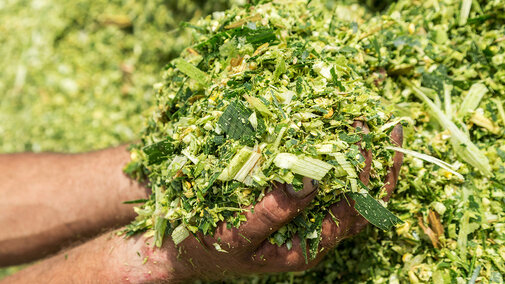Drought Corn for Silage
High input costs and dry conditions mean making the most out of every forage opportunity critical this year. If corn fields aren’t producing a grain crop, can we capture value in other ways?
While drought-stressed corn may look like a lost crop, the value as silage may still be present. Even if corn has no grain, we can expect 80-90% of the energy value found in regular corn silage. This energy is in a bit different form, however, and should impact our management decisions. Instead of starch in grain, energy is still in sugars in the stalk. Because of this, getting a quick and efficient fermentation is critical to capturing as much value as possible before molds, yeast and harmful bacteria can begin chipping away. In these cases, using quality inoculant to speed up fermentation and improve stability is a good idea.
Another value of silage production the opportunity to lower nitrate risks. While other options like grazing and haying may be a way to use droughty corn, they pose a very high risk of locking in toxic levels of nitrates that may have accumulating in the forage. When ensiled properly, silage fermentation can reduce nitrate levels up to 50%.
Finally, it can be tricky to accurately assess moisture levels on drought-impacted corn. While it may look overly dry, corn — especially without ears to signal the plant to dry down — can retain high levels of moisture in the stock for well into the fall. Before you cut, take a test strip if possible or hand sample even dry-looking corn stands to ensure moisture levels are right.
Drought-stressed corn may still provide valuable forage, especially as silage. Ferment fast to capture energy value, keep an eye on true moisture levels and watch nitrates for success.
Storage Methods to Reduce Hay Losses
Hay is a very valuable commodity this year. So, as you bring in your round bales for winter storage and feeding, store them to minimize weather losses.
Hay stored outside will be damaged by rain, snow, wind and ice this fall and winter. The average round bale may lose up to one-fourth of its original nutrients during storage, but these losses can be reduced to less than 10% or so.
For instance, do you usually line up bales for easy access, so the twine sides touch each other? Or do you stack your bales? If so, extra spoilage will occur where these bales touch because rain, snow and ice will gather in spots where bales touch instead of running off. Research has shown that round bales stacked in a pyramid form will have greater dry matter losses compared bales butted end-to-end, cigar-like.
Does snow drift around your bales? Bales placed in east-west rows often have drifts on the south side. Hay next to fencelines or trees can get extra snow. As snow melts, it soaks into bales or makes the ground muddy. Plus, the north side never gets any sun so it's slow to dry. This year, line your bales up north-and-south for fewer drifts and faster drying as sunlight and prevailing winds hit both sides of the row.
Most important is the bottom of your bales. Always put bales on higher, well-drained ground so water drains away from them. If necessary, use crushed rock, railroad ties or even pallets to elevate bales to keep the bottoms dry. This also will reduce problems getting to your hay or getting it moved due to snow drifts or mud.
So, for outside storage, a single row of bales end to end — along with consideration for row orientation and the ground surface drainage — will be the best storage method.
Storing and Protecting Corn Silage
By Brad Schick
Making good silage includes many factors. Are you prepared to address the critical control points?
The time and money spent on chopping silage for feed does not go unnoticed. Harvest time, moisture, processing, chop length, pack density and fermentation efficiency all contribute to the preservation of the nutrients that have been grown all summer.
The correct packing density is one of the most overlooked pieces of the process. A good density goal is to have 14 lb. of dry matter per cubic foot. Pack only a four- to six-inch layer at a time and have proper tractor weight.
The 800 rule can be used to determine how fast a tractor can pack based on weight. Take the weight of the tractor and divide by 800. That will give a how many tons per hour a tractor can pack to have a good density. For example, if the tractor weights 32,000 and we divide by 800, resulting in 40 tons per hour that tractor can pack. The speed of chopping should be determined by the packing speed, not the silage chopper.
The next item is to cover the pile. Even after the silage is packed correctly, air and water can penetrate the outer layers and severely damage the quality and quantity of silage. Additionally, molds, mycotoxins and fungi have a prime place to grow in uncovered silage.
Many studies at Kansas State University have reported a from 3% to 40% loss in dry matter from the top three feet of silage in uncovered silage bunkers compared to covered. Covering with plastic will give about an 8:1 return on investment for the producer.
Silage should be covered as soon as possible with plastic. The standard plastic is still the black and white sided 6mil sheeting. Make sure the edges are sealed and the top has plenty of weight on it.
A good pack and a good cover can reduce losses, increase profit and be safer when facing the pile.

